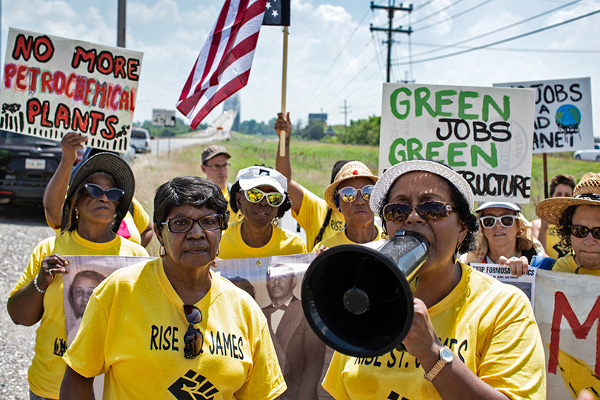
PHOTO/JULIE DERMANSKY
Below are excerpts from a longer article by Julie Dermansky of DESMOG at www.desmogblog.com/
NEW ORLEANS, LA — On the evening of January 6, 2020, Louisiana state regulators issued 15 key permits to the Taiwanese petrochemical corporation Formosa for its $9.4 billion plastics manufacturing complex proposed for the historically Black area of St. James Parish. The approvals paves the way for the project’s construction, [which is] opposed by local and national environmental advocates.
Sharon Lavigne, a demure, 67-year-old recently retired special-ed teacher born and raised in St. James Parish, cried when she heard the news. Her community along the Mississippi River is already saddled with petrochemical plants and oil storage tanks, which release known carcinogens into the air that she fears are making her and her family sick.
“Something isn’t right about this,” said Lavigne, who founded the community group RISE St. James to oppose new industrial development in the area. After doing everything she could to raise awareness about why Formosa shouldn’t build its plastics plant in St. James, she is baffled by the state’s decision.
“If they think we are going to sit around and let them poison us, they are wrong,” Lavigne said. She is ready for the next round in the fight to stop the plastics complex. “God is on my side. He has sent me the people I need to help fight this fight, and that is what I’m going to do.”
She is trying to stop the corporation from building a sprawling plastic manufacturing complex a mile and a half from her front door.
St. James Parish is in the middle of an 80-mile stretch of the Mississippi River, from just outside of New Orleans up to Baton Rouge. It used to be known for its bucolic landscape lined with sugarcane fields, former slave plantations, and churches, but over the last 50 years, it has been transforming into an industrial wasteland.
That transformation is poised to worsen tenfold as more petrochemical companies build mega-plastic manufacturing plants, dwarfing the facilities already polluting the region known to industry as the Petrochemical Corridor, and to locals as Cancer Alley.
The project was endorsed by Democratic Governor John Bel Edwards before the community even knew about it. He was the first to announce the project, welcoming Formosa to Louisiana . . .
Ed. Note: Environmental groups are suing the Trump administration, challenging the permits given to the company by the governor, and exposing the impact of chemical corporations in rural poor and Black communities in Louisiana and on the global environment.
The plastics giant and the making of an environmental justice warrior
Latest
The People’s Tribune opens its pages to voices of the movement for change. Our articles are written by individuals or organizations, along with our own reporting. Bylined articles reflect the views of the authors. Articles entitled “From the Editors” reflect the views of the editorial board. Please credit the source when sharing: peoplestribune.org. Please donate to help us keep bringing you voices of the movement for change. Click here. We’re all volunteer, no paid staff. The People’s Tribune is a 501C4 organization.

